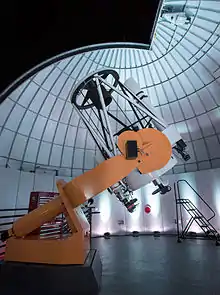DFM Engineering
DFM Engineering is an American telescope and optics manufacturer founded in 1979 by Frank Melsheimer in Longmont, Colorado.[1][2] DFM makes medium size Cassegrain telescopes and their associated systems including telescope optics, control systems, and mounts. A range of pre-designed telescopes are made, as are various custom installations. DFM produces its classical Cassegrain design in various apertures from 16 inches (0.4 m) to 50 inches (1.3 m) and larger.[3] The base DFM 16-inch (40 cm) telescope system cost roughly 94 thousand USD in 2005.[4]


DFM produced a 1.6 m solar telescope for the Big Bear Solar Observatory.[5] The United States Navy purchased a 1.3 m (51-inch) DFM telescope for the United States Naval Observatory Flagstaff Station in Arizona, USA.[6]
DFM installations include many universities and institutions, including: Alfred University, Appalachian State University, Central Michigan University, Chabot Center, Clay Center-Dexter School, College of Charleston, College of Southern Idaho, Colorado University, Dickinson College, Emory University, Embry-Riddle Aeronautical University, Daytona Beach, Florida Institute of Technology, Johns Hopkins University, Lewis & Clark College, Middlebury College, PARI / UNCA, Rowan University, Westmont College,[7] University of Alabama, University of Calgary, University of Victoria, University of Michigan, University of Montreal, University of Wyoming, Valdosta State University, Virginia Military Institute, Williams College, Academia Sinica Institute of Astronomy and Astrophysics and University of the Free State.
DFM engineering produced the telescope for the Asteroid Terrestrial-impact Last Alert System (ATLAS) project.[8] ATLAS was funded by a grant from NASA and includes initially two telescopes set 100 miles (160 km) apart.[9] The telescopes were tested by DFM in Colorado, U.S. in 2015 and are now operational in the Hawaiian Islands.[10] The telescopes are designed to detect large near-Earth objects and identify those which threaten to impact Earth.[11]
DFM also produced the telescope for Meter Class Autonomous Telescope (MCAT).[12] MCAT is designed to look for space debris, with a wide (41 degree) field of view, f/4 optics, and 1.4 m aperture.[13] It is a reflecting telescope on a double horseshoe mount.[14] MCAT is located on Ascension Island in the South Atlantic Ocean.[15]
References
- "Company Profile". DFM Engineering. Retrieved April 6, 2017.
- "Software Bisque". www.bisque.com. Retrieved 2017-01-11.
- The Dfm Engineering 0.4-METER Telescope
- https://web.archive.org/web/20080409233826/http://www.phys-astro.sonoma.edu/observatory/roboscope/commercial_roboscopes.html#dfm
- Newsworthy Articles
- U.S. Naval Observatory Flagstaff - 1.3-m Reflector
- Brown, J'Amy. "Westmont Gets New Telescope". www.independent.com. Retrieved 2019-01-01.
- "Asteroid Early-Warning System for Potential Impacts Makes Progress". Retrieved 2017-01-11.
- "Asteroid Early-Warning System for Potential Impacts Makes Progress". news.yahoo.com. Retrieved 2019-01-01.
- "Unique Scope Searches for Space Junk". Sky & Telescope. 2015-11-17. Retrieved 2019-01-01.
- "Unique Scope Searches for Space Junk - Sky & Telescope". Sky & Telescope. 2015-11-17. Retrieved 2017-01-11.